Basic AI Chatbot Pricing: A simple chatbot that can answer questions about a product or service might cost around $10,000 to develop.
Read More

Is your AI app just smart or is it also usable?
Because here’s the truth: nobody cares how powerful your AI model is if the interface frustrates them.
In fact, 52% of users say a bad mobile experience makes them less likely to engage with a brand, and AI apps are no exception.
When it comes to user retention, functionality is just the beginning.
What truly sets apart successful AI apps is how well they’re designed to communicate, engage, and build trust with users.
Too many AI applications are technically brilliant but fail to connect with the people they’re built for.
The result?
Confusion. Drop-offs. Distrust.
This guide is for forward-thinking founders, product strategists, and innovation teams who want to change that.
We’re breaking down how to design an AI app, not just build one. You’ll learn:
Whether you're launching a startup MVP or scaling with an experienced AI app development company, this is your blueprint to align artificial intelligence with real human intelligence.
Let’s begin.
AI without great design is like a Ferrari with no steering wheel.
It looks impressive, but nobody’s going anywhere fast.
In today’s competitive digital landscape, it’s not enough for your AI app to work.
It needs to work for the user.
That means clear interfaces, frictionless navigation, and thoughtful interactions that inspire confidence, not confusion.
Here’s what most businesses overlook: the design of your AI app is often the first (and sometimes the only) impression your users will have of your brand.
A confusing or clunky interface can make even the smartest AI look dumb, and that’s bad for both perception and performance.
Here’s what smart AI app design really does for your business:
| Benefit | Impact on Business |
|---|---|
|
Higher user adoption |
Users understand and trust the AI functionality faster |
|
Increased engagement & retention |
Smooth, intuitive flows keep users coming back |
|
Lower support costs |
Good design reduces confusion and customer complaints |
|
Better data collection |
Seamless UX encourages more natural user input |
|
Competitive differentiation |
Great UI/UX is still rare in AI apps—stand out easily |
|
Stronger brand trust |
Transparent AI builds credibility with users |
According to Forrester, companies that invest in UX see a return of $100 for every $1 spent. That ROI multiplies when enterprise AI solutions are paired with thoughtful design, bridging complex systems with seamless user experiences.
Basically, your AI app doesn’t need to look like Iron Man’s dashboard. What it really needs is clarity, flow, and trustworthiness.
When users feel in control, not confused or second-guessing what the AI is doing, they stick around.
They use it. They recommend it.
That’s where great AI App UI/UX Design earns its keep:
It doesn’t just support your AI product.
It sells it.
Next up: the design principles that actually make this happen without drowning in complexity.
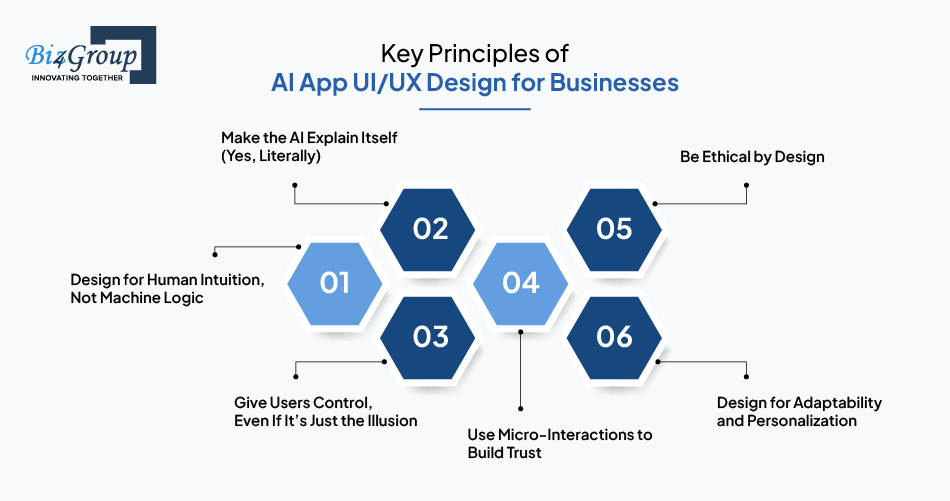
Designing a user-friendly AI app isn’t about making things “look cool.”
It’s about building an experience that feels natural, trustworthy, and easy to navigate, even when what’s under the hood is highly complex.
So how do you bridge that gap between machine intelligence and human expectations?
These are the non-negotiables of smart, scalable UX design for AI applications:
Just because an algorithm can handle 50 tasks at once doesn’t mean users should see them all at once.
Simplify. Prioritize. Hide complexity when it’s not needed. Reveal it when it adds value.
Your AI may be powerful, but your UI should feel effortless.
People don’t trust what they don’t understand.
Design your app to show how and why it made a decision, whether that’s a product recommendation, risk score, or chatbot response.
This is called explainable UX, and it’s key to building trust.
Nobody likes feeling at the mercy of a black-box system.
Provide clear ways to review, override, or refine AI decisions.
When users feel empowered, they’re more likely to trust and adopt your app.
AI can feel impersonal, but your design shouldn’t.
Subtle UI cues like loading animations, confirmation messages, and progress bars create emotional feedback loops that make your app feel responsive and alive.
It’s small stuff but it adds up.
From the moment users open your app, your design choices shape their perception of fairness and privacy.
Ethical AI isn’t just a technical decision. It’s a design decision.
Smart apps adapt.
Your UI should too.
Use behavioral data (ethically) to personalize content, layout, and responses. Let the interface evolve based on how users interact with it, just like how smart AI automation services continuously adapt to business workflows.
Just remember: the goal isn’t to “wow” users.
It’s to help them get what they need—faster, smarter, and more confidently.
Let’s flip the script. Design AI experiences people actually enjoy using.
Talk to Our UX StrategistSo, what does great AI App UI/UX Design actually look like in the wild?
We’re not talking about theoretical wireframes or design trends. We mean real companies using AI, thoughtfully designed, to solve real problems for real people. Whether you’re in healthcare, retail, logistics, or edtech, great design is what helps AI earn user trust, and drive business value.
The Challenge:
Patients often hesitate to trust AI-generated diagnoses.
The Design Solution:
Apps like Ada Health and Buoy Health use conversational interfaces, confidence scores, and clear symptom logic to guide users, like a friendly digital doctor, not a cold algorithm.
UX Highlight:
The Challenge:
Risk scoring and financial advice can feel opaque or invasive.
The Design Solution:
AI apps like Cleo or YNAB use humor, plain language, and interactive visualizations to coach users rather than command them.
UX Highlight:
The Challenge:
Overpersonalization can feel intrusive, especially without context.
The Design Solution:
Retail apps like Stitch Fix and Sephora use AI to make recommendations, whether it’s a product picker or a customer service AI chatbot, but always with opt-ins, previews, and clear customization options.
UX Highlight:
The Challenge:
In B2B software, users care more about getting results than knowing how AI works.
The Design Solution:
Tools like Notion AI and Gong.io use subtle UX cues—like real-time suggestions, inline automation, and fallback options—to enhance productivity without distracting users.
UX Highlight:
The Challenge:
Learners need content tailored to their pace and style—without feeling judged or overwhelmed.
The Design Solution:
Platforms like Duolingo and Querium—and many built by a seasoned AI chatbot development company—use AI to adjust difficulty levels, personalize quizzes, and offer bite-sized lessons based on real-time performance.
UX Highlight:
The Challenge:
Operational teams need actionable insights, not just raw AI data.
The Design Solution:
Tools like FourKites or Project44 present real-time supply chain forecasts and route optimizations using dashboards designed for fast decision-making.
UX Highlight:
These examples have one thing in common: the AI is smart, but the design makes it approachable.
When you combine strong AI capabilities with thoughtful, user-first UX, the result isn’t just a cool feature.
It’s a product people actually want to use and keep using.
Next, we’ll show you how to make that happen with a proven, scalable design process.
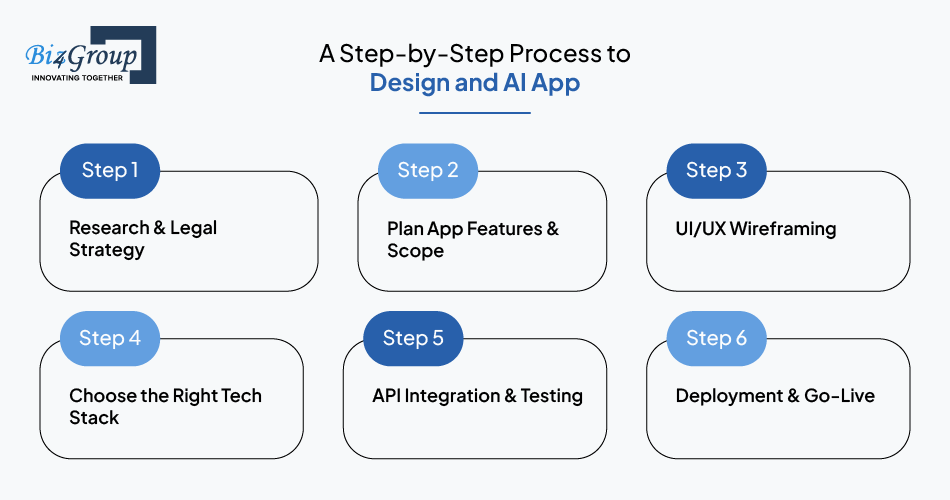
Now that we’ve seen what great looks like, let’s break down exactly how to design an AI app that delivers a seamless, trust-building user experience.
This process isn’t about stuffing AI into an interface and hoping for the best.
It’s about aligning intelligence with intention, designing AI around the user, not the other way around.
Here’s a 6-step UI/UX design process to help you build AI-powered apps that feel natural, valuable, and human:
Most teams begin with the model: “What can our AI do?”
Flip it.
Start with: “What’s the user struggling with?”
You’re not building AI to show off technical brilliance, you’re solving a real human challenge. A seasoned AI development company will always align tech capabilities with genuine user needs.
AI should serve the user, not surprise them.
What to do:
Pro tip: If you can’t explain how your AI helps the user in one sentence, it’s not ready for design yet.
Once you know where AI belongs, map out the complete flow of interaction, from input to decision to feedback.
Focus on:
Use flowcharts or journey maps to show both success and fallback scenarios.
Your goal isn’t a perfect algorithm—it’s a resilient experience.
Now turn ideas into visuals. Start lean.
Think low-fidelity wireframes with just enough fidelity to test layouts and interactions.
Include:
Good wireframes ask more questions than they answer.
Use them to find out: Do users “get” what’s happening, and do they feel in control?
Users don’t engage with wireframes—they engage with motion, tone, and timing. That’s where prototypes come in.
What to prototype:
Bonus: Use mock data that feels realistic, even if it’s fake.
People need to react emotionally to the experience, not just technically.
Test. Observe. Repeat.
What to validate:
Ask qualitative and quantitative questions:
“How confident are you in this recommendation?”
“What would you expect to happen if you changed your input?”
Don’t just test usability... test trust.
Your AI might be accurate, but if users don’t believe in it, you’ve still lost.
AI is not static, neither is your interface.
The final step—often powered by AI integration services—is building your app so it can learn from your users just as much as they learn from it.
Build in:
Growth isn’t just about scaling the tech. It’s about scaling the experience, making sure your AI app design stays user focused as your product evolves.
Honestly, no amount of machine learning can fix bad design.
The brands winning in AI right now? They’re not just shipping models. They’re crafting fluid, transparent, emotionally intelligent experiences, and they’re doing it by following a UX-first approach.
Also read: The top UI/UX design companies in the USA
From sketch to scale—we turn bold AI ideas into seamless, scalable apps.
Schedule a Free CallNow, let’s talk about the UI/UX practices that elevate your design from usable to unforgettable.
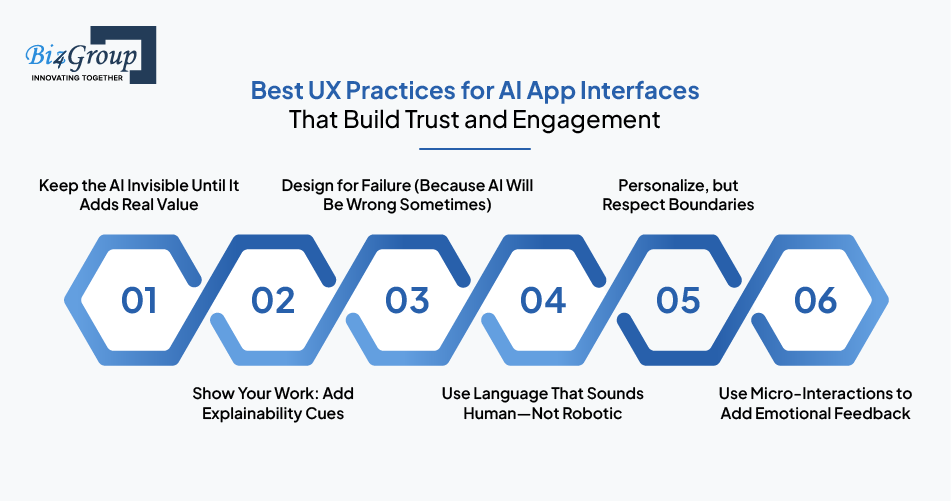
Good UX helps users complete tasks.
Great UX makes them feel confident doing it, even when AI is in the driver’s seat.
Designing interfaces for AI-powered apps comes with its own set of challenges.
The logic isn't always obvious, the outcomes aren’t always predictable, and users can be skeptical of handing control over to something they don’t fully understand.
That’s where smart, strategic AI App UI/UX Design comes in.
Here are the UX practices that separate intuitive, trustworthy AI apps from the ones users abandon on day one:
Users don’t need to know your app uses neural networks. They just want to get something done.
Let the AI stay in the background unless it’s doing something the user actually needs to see.
What this looks like:
Think of it this way: users shouldn’t be surprised there’s AI... just happy it’s there.
Your app shouldn’t feel like it’s making secret decisions behind the curtain.
Users trust what they can understand, even if they don’t fully grasp the tech.
How to do it:
Explainability is not just for regulators. It’s for your users.
No matter how accurate your model is, users will run into unexpected outcomes. Don’t let that moment kill trust.
Smart fallback UX includes:
Users forgive imperfect AI. What they won’t forgive is having no way out when it fails.
If your AI responses sound like they were written by a math professor, users will check out fast.
What works:
Users don’t want to decode what your app is saying. Your copy should be clear, concise, and conversational.
Yes, AI can personalize content at scale, but that doesn’t mean users want to feel watched.
Keep personalization user-friendly:
The best personalization feels like a thoughtful recommendation, not a creepy guess.
Design is emotional, even in AI-driven apps.
Tiny visual or behavioral cues help users feel like the app is responding to them.
Where it matters:
Done right, these touches create a sense of momentum and clarity, especially during AI processing moments.
Interestingly, the same AI that powers your product can also shape how it’s designed—here’s how you can use AI for UX design to build even smarter, more adaptive experiences.
See, your users don’t care how smart your algorithm is. They care how smart your product feels.
Great UX doesn’t just help users navigate your app.
It builds confidence in the intelligence behind it.
It reduces friction, inspires trust, and makes users feel good about what they’re doing, no matter how complex the technology under the hood, exactly what you’d expect from a top software development company in the USA.
That’s the real goal of UX design for AI applications: making artificial intelligence feel natural.
Now, let’s talk about the common UX mistakes that quietly sabotage even the best AI app designs, and how to avoid them.
AI is complex, but your user interface shouldn’t be.
Unfortunately, many AI apps lose user trust (and traction) not because of weak algorithms, but because of avoidable UX mistakes. These slip-ups often seem minor, but they add friction, create confusion, and erode confidence—fast.
Let’s walk through the most common UX mistakes in AI app design, and how you can avoid them from day one.
It’s easy to fall in love with what your model can do.
But if your app experience is structured around your AI’s capabilities instead of your user's goals, you’re designing backward.
Avoid this by:
If users don’t know why something happened, they’ll assume your app is broken, or worse, biased.
Avoid this by:
If users feel like they’re guessing, they’ll stop using the app. Simple as that.
Yes, AI can do a lot, but should it do it all at once?
When every screen is packed with suggestions, predictions, and automation, the result is mental fatigue, not delight.
Avoid this by:
Smart design is about focus, not feature-stuffing.
You can’t assume users will just “get it.”
If your app includes unique or unfamiliar AI behaviors, you need to show (not just tell) how it works.
Avoid this by:
If users have to ask, “What just happened?”, you’ve already lost them.
When users feel stuck or overruled by AI, frustration sets in.
Avoid this by:
Override doesn’t make your AI look weak. It makes your design look thoughtful.
AI might be analytical, but your UI doesn’t have to sound like a machine.
Avoid this by:
Your users aren’t engineers... they’re people. Write for them.
The biggest danger in AI app design for businesses isn’t model failure—it’s user abandonment. And that happens when trust breaks down.
These UX mistakes are subtle, but they’re costly.
The good news? They’re entirely preventable.
Design with empathy, test with real users, and always, always give people a way to understand and interact with the AI, not just be subject to it.
You bring the vision, we’ll bring the blueprint (and the battle-tested fixes).
Solve Your UX Challenges with UsNext up, let’s cover the metrics that tell you whether your UX strategy is actually working, or quietly falling short.
You can’t improve what you don’t measure.
Designing an AI app with a seamless user experience is only half the battle, the other half is knowing whether it’s actually working.
Too many teams obsess over technical AI metrics (like model accuracy or F1 scores), while ignoring the signals that users are silently sending through their behavior—often the result of investing too little in design clarity.
If you’re unsure how much to budget for great UX, check out our UI/UX design cost guide.
And if you want to build trust, increase adoption, and create long-term product success, these are the UX-focused metrics that matter.
Is your AI experience actually being used? Track:
Healthy engagement signals that users find the AI both usable and valuable.
Great AI design helps users get things done—faster and easier. Track:
A drop in drop-offs? That’s UX magic at work.
This is the tricky part, measuring how much users believe in your AI. Track:
Add micro-surveys directly into the interface to gather this data in context, when trust is gained or lost in real-time.
No AI is perfect. The question is: can your UX recover gracefully? Track:
A well-designed UX doesn’t eliminate AI mistakes. It makes them survivable.
Support tickets and user churn are where poor UX usually leaves its mark. Track:
These are your red flags, and your design team's best clues.
Numbers are great.
But don’t sleep on open-ended insights.
Watch usability sessions. Read in-app feedback. Conduct post-launch interviews.
Sometimes, one frustrated user can tell you more than 10 dashboards combined.
Strong AI is built on data.
But strong AI design is built on the right data. The kind that tells you how users feel, not just what they click.
Track these UX metrics consistently, and you’ll do more than make a smarter app.
You’ll create an experience users trust, enjoy, and keep coming back to.
Let’s measure what matters, and design what converts.
Design With UsIf you’ve made it this far, it’s clear you understand the importance of design in AI app success.
But knowing what makes a great AI app is one thing—building it right is another.
That’s where we come in.
Biz4Group is a leading UI/UX Design Company in the USA, specializing in AI-powered digital solutions for startups, enterprises, and SaaS brands.
We don’t just build apps—we help founders, product teams, and innovation leaders design smarter AI experiences from the ground up.
We’re not vendors. We’re your trusted advisors, from first wireframe to post-launch growth.
Here’s what sets us apart:
Design-First Thinking
We don’t just slap AI into a product. We craft the entire user experience around it.
Proven UX + AI Expertise
Our teams blend top-tier UI/UX strategy with deep AI/ML knowledge to deliver apps that users actually understand and love.
Cross-Industry Case Studies
From eCommerce to enterprise logistics, we’ve designed AI solutions that drive results.
Startup Friendly, Enterprise Ready
Whether you’re launching a product or scaling an ecosystem, we adapt to your vision and growth stage.
Human + Tech Harmony
We don’t chase shiny objects. We design tech that solves real problems with empathy and precision.
Full-Cycle Support
Strategy → Wireframing → Prototyping → Development → Post-launch optimization.
One team. Zero handoffs.
If you're serious about creating an AI app that stands out, scales, and earns user trust, Biz4Group is your unfair advantage.
Curious how much it takes to bring your AI app vision to life before scaling like these? Here’s a detailed breakdown on how much it costs to build an MVP for AI applications. Now, let’s back it up with real-world results.
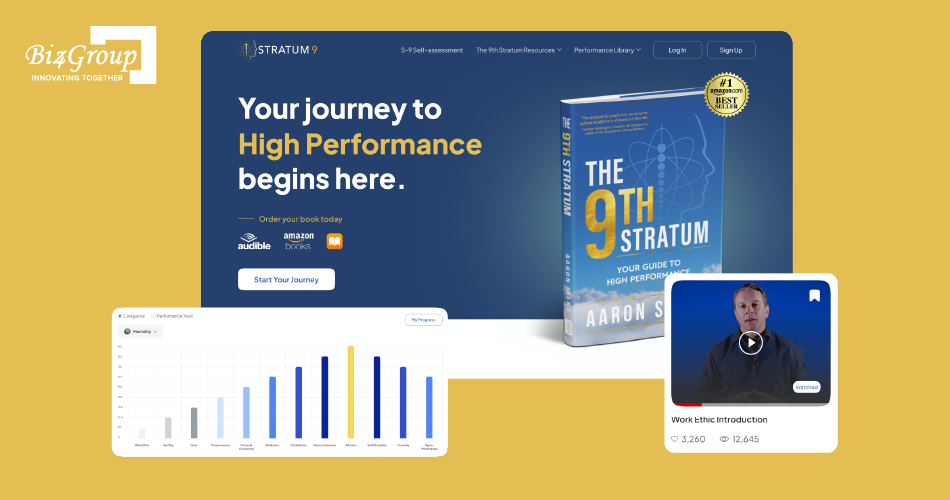
When Stratum 9 came to us, their vision was ambitious: take the essence of a powerful personal development book and transform it into an engaging, interactive digital experience.
The result? A beautifully designed, AI-powered performance platform that’s now helping users grow into high performers, one interpersonal skill at a time.
Biz4Group brought this vision to life across iOS, Android, and web, crafting a seamless UI/UX experience that turns complex self-growth content into digestible, gamified learning.
We didn’t just digitize a book—we reimagined it as a lifelong learning system:
| Challenge | How We Solved It |
|---|---|
|
Presenting 45 skills without overwhelming users |
Used visual tiering, categories, and intuitive navigation to create modular clarity |
|
Creating assessments that feel smart—not boring |
Designed interactive, adaptive quizzes with feedback loops and custom content |
|
Keeping load times fast despite feature depth |
Leveraged CDN, caching, and scalable cloud infrastructure for smooth performance |
|
Ensuring a smooth experience at scale |
Implemented backend load balancing and frontend optimization |
A robust, scalable performance improvement platform that feels personal, engaging, and purposeful, built on great UX design that users love to come back to.
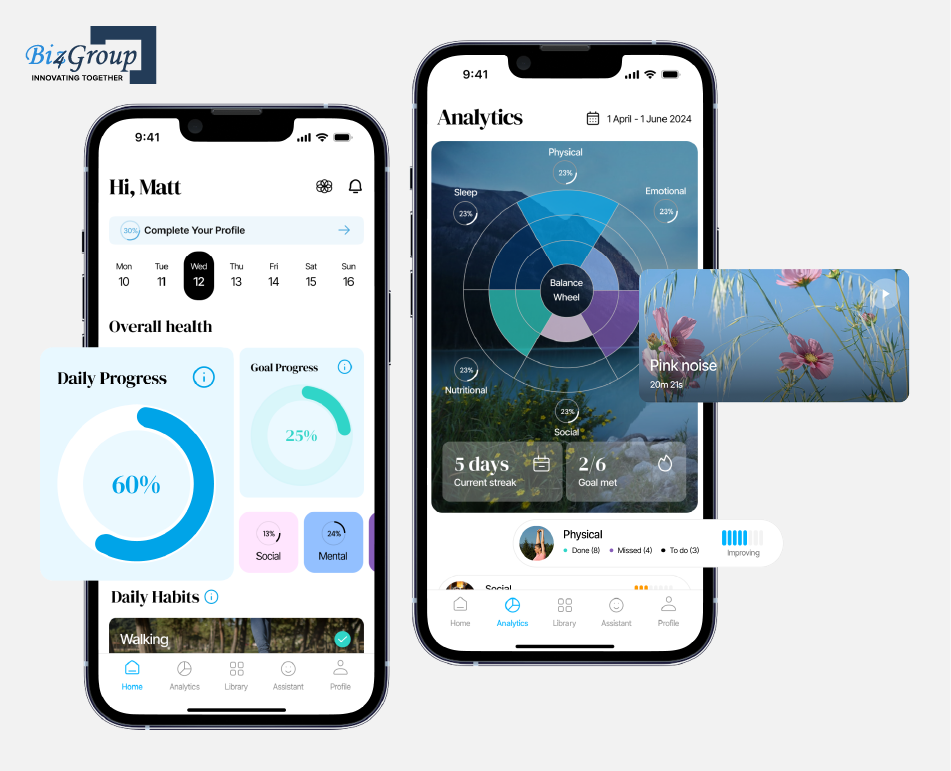
Most self-improvement apps focus on just one dimension—fitness, sleep, or mindfulness. But real growth is holistic.
That’s why Quantum Fit set out to do what few apps have done: combine advanced AI with thoughtful UX design to create a seamless, all-in-one personal development platform. From habit tracking to personalized growth plans, the experience was crafted to feel smart, supportive, and surprisingly simple.
With Biz4Group as their trusted advisor, the result was a multi-platform AI-powered app that adapts to each user’s goals, intuitively and intelligently.
Quantum Fit was designed for real-world usability, balancing AI sophistication with interface simplicity:
| Challenge | How We Solved It |
|---|---|
|
Managing the cost of high-volume AI use |
Implemented smart token management and caching to optimize GPT-4o resource usage |
|
Delivering deep personalization at scale |
Developed adaptive AI logic to continuously tailor plans to evolving user inputs |
|
Balancing AI complexity with simplicity |
Crafted an intuitive layout that makes smart features feel effortless to navigate |
A truly intelligent personal development platform that doesn’t just tell users what to do, it guides them, adapts with them, and celebrates every step of progress.
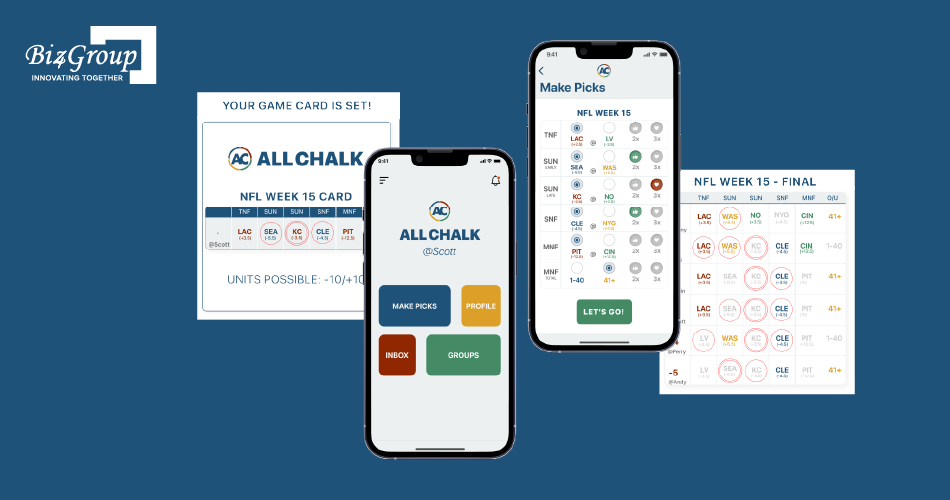
When it comes to sports prediction apps, user excitement only counts if the experience keeps up with the pace of the game. All Chalk set out to deliver exactly that: a global Pick’em platform offering smooth predictions, real-time leaderboards, and game reminders, without diving into complex betting interfaces.
Biz4Group stepped in to design and build a cross-platform mobile application that’s as fast, fun, and reliable as sports fans demand, optimized for both engagement and scale.
We brought the vision of All Chalk to life through a streamlined experience that balances powerful backend architecture with frictionless UI/UX:
| Challenge | How We Solved It |
|---|---|
|
Handling spikes in traffic during game time |
Built a highly scalable backend using PostgreSQL + Express.js on AWS infrastructure |
|
Real-time leaderboard updates |
Implemented efficient synchronization using solutions from our Node JS development company to ensure instant data accuracy |
|
Ensuring a unified experience across platforms |
Used Ionic + React.js to create seamless UX across iOS and Android with minimal code duplication |
|
Securing sensitive user data |
Integrated advanced encryption protocols to ensure compliance and user trust |
A lightning-fast, visually clean, and highly secure sports Pick’em platform that users love to open before every game week. All Chalk doesn’t just display data—it builds excitement and community through smart design and real-time interactivity.
From personal growth platforms to high-traffic prediction engines, we’ve helped businesses turn bold AI visions into beautifully functional realities. At Biz4Group, we don’t just design interfaces—we design trust, momentum, and long-term product success.
So when you’re ready to build an AI-powered app that users don’t just use but rely on, talk about, and come back to, give us a call.
Let’s design something exceptional.
Building an AI-powered app is no longer just a tech challenge—it’s a design challenge.
Your users don’t care how many parameters your model has or which framework you used. They care about clarity. Confidence. Control.
They want an app that feels intelligent and intuitive.
The difference between another forgettable tool and a truly successful AI product?
Thoughtful, human-centered UI/UX design.
From defining the problem to deploying clean, scalable interfaces, the process you follow (and who you hire as AI developers) can make or break your app’s future.
And that’s why Biz4Group is here for you.
We’re here to help you not just build an AI app, but to design an experience your users believe in.
Ready to lead with better design? Let’s talk.
Not at all. In fact, it’s ideal to start with UX planning before your AI model is finalized. We help you map out interaction flows, user expectations, and interface design early, so when the model is ready, your app is too.
Timelines vary by scope, but most design phases (research, wireframes, prototypes, validation) take 4–8 weeks. We move faster for MVPs and offer phased rollouts for larger platforms.
That’s exactly what good design solves. We specialize in creating simple, human-centered experiences that help even non-technical users trust and engage with AI, without needing to understand the backend.
Transparency is key. Use confidence indicators, fallback suggestions, and clear language to manage expectations. Great AI app design prepares the user for imperfect outputs, and gives them tools to correct or override them.
The key is to balance control and convenience. Let users opt into AI features gradually, offer manual alternatives, and use onboarding to explain what the AI does and why. Progressive disclosure is your friend, don’t show everything at once. A smart generative AI development company can help you strike the right balance between control and automation.
A critical one. Feedback helps you refine the UX, catch blind spots, and improve trust. Use in-app surveys, feedback prompts, and analytics to gather insights, and iterate quickly. AI apps should evolve with their users.
Transparency is key. Use confidence indicators, fallback suggestions, and clear language to manage expectations. Great AI app design prepares the user for imperfect outputs, and gives them tools to correct or override them.
with Biz4Group today!
Our website require some cookies to function properly. Read our privacy policy to know more.